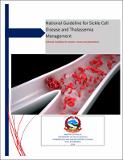Please use this identifier to cite or link to this item:
https://hdl.handle.net/20.500.14356/2471| Title: | National Guideline for Sickle Cell Disease and Thalassemia Management |
| Authors: | Rayamajhi, Ajit Jha, Runa Poudyal, Bishesh Sharma Pandey, Rajan Tuladhar, Sampurna |
| Citation: | Ministry of Health, Department of Health Services, Epidemiology and Disease Control Division |
| Issue Date: | Apr-2017 |
| Publisher: | Ministry of Health, Department of Health Services, Epidemiology and Disease Control Division, Teku, Kathmandu |
| Keywords: | Clinical Guideline Doctors Nurses Paramedics National Guideline Sickle Cell Disease and Thalassemia Sickle Cell Disease and Thalassemia Management |
| Abstract: | Glossary of Terms and Definitions HbSS: People who have this form of SCD inherit two sickle cell genes (“S”), one from each parent. This is commonly called sickle cell anemia and is usually the most severe form of the disease. HbSC: People who have this form of SCD inherit a sickle cell gene (“S”) from one parent and from the other parent a gene for an abnormal hemoglobin called “C”. Hemoglobin is a protein that allows red blood cells to carry oxygen to all parts of the body. This is usually a milder form of SCD. HbS beta thalassemia: People who have this form of SCD inherit one sickle cell gene (“S”) from one parent and one gene for beta thalassemia, another type of anemia, from the other parent. There are two types of beta thalassemia: “0” and “+”. Those with HbS beta 0- thalassemia usually have a severe form of SCD. People with HbS beta +-thalassemia tend to have a milder form of SCD. HbSD, HbSE, and HbSO (raretypes): People who have these forms of SCD inherit one sickle cell gene (“S”) and one gene from an abnormal type of hemoglobin (“D”, “E”, or “O”). Hemoglobin is a protein that allows red blood cells to carry oxygen to all parts of the body. The severity of these rarer types of SCD varies. Sickle Cell Trait (SCT),HbAS: People who have SCT inherit one sickle cell gene (“S”) from one parent and one normal gene (“A”) from the other parent. This is called sickle cell trait (SCT). People with SCT usually do not have any of the signs of the disease and live a normal life, but they can pass the trait on to their children. Additionally, there are a few, uncommon health problems that may potentially be related to sickle cell trait. |
| Description: | Guideline |
| URI: | https://hdl.handle.net/20.500.14356/2471 |
| Appears in Collections: | Guideline |
Files in This Item:
| File | Description | Size | Format | |
|---|---|---|---|---|
| national guidelines.pdf | Download Guideline. | 1.43 MB | Adobe PDF |  View/Open |
Items in DSpace are protected by copyright, with all rights reserved, unless otherwise indicated.
